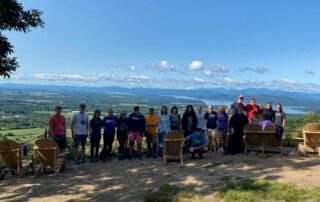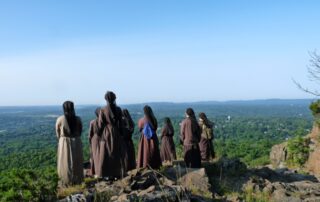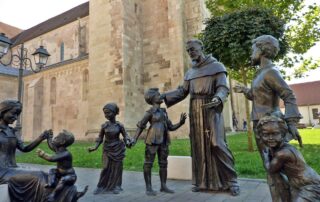 Pillar: Little Portion
Pillar: Little Portion
Laudato Si’ Action Plan Goals: Community Engagement and Participatory Action
 Pillar: Little Portion
Pillar: Little Portion
Laudato Si’ Action Plan Goals: Community Engagement and Participatory Action
Group (Grade Levels): Can be adapted for any age group or an inter-generational group
Learning Goals:
- Develop a deeper relationship with a local place through prayer and action.
- Experience human capacity to sanctify time and space through engaging in a pilgrimage.
- Learn to engage all in the participating community, including those marginalized by physical, financial, emotional, intellectual limitations.
Materials Needed: Materials needed will vary.
Estimated Time to Complete Activity: Variable. Keeping the pilgrimage to one day makes it more accessible for more people.
Estimated Number of Sessions if Activity Continues: Possibility for annual participation. Could be done as frequently as weekly if the pilgrimage site is close and integrated into routines, such as prayers at a near-by parish.
Pre-planning:
- Choose a close-by destination for your pilgrimage and reach out to relevant persons to arrange the pilgrimage. Some options are:
- A special parish/shrine in your diocese, or an old, historically interesting parish
- A ministry of your diocese or parish, such as a soup kitchen, pregnancy resource center, or community center for children
- A civic monument or other location that has spiritual significance, such as a memorial to veterans of wars
- Identify a theme that matches the location and your age group.
- Consider preparing a booklet that gives information about the site and the readings/prayers you will do as a group.
- Invite a special guest with a particular interest related to the pilgrimage to participate.
- Depending on age, involve participants in the planning of the pilgrimage.
General Outline of Experience
Suggestions:
- If possible, begin the day with Mass and ask the celebrant to incorporate themes of pilgrimage.
- Before leaving for the place of pilgrimage, proclaim Exodus 3 and reflect on it with the group:
Meanwhile Moses was tending the flock of his father-in-law Jethro, the priest of Midian. Leading the flock beyond the wilderness, he came to the mountain of God, Horeb. There the angel of the Lord appeared to him as fire flaming out of a bush. When he looked, although the bush was on fire, it was not being consumed. So Moses decided, “I must turn aside to look at this remarkable sight. Why does the bush not burn up?” When the Lord saw that he had turned aside to look, God called out to him from the bush: Moses! Moses! He answered, “Here I am.” God said: Do not come near! Remove your sandals from your feet, for the place where you stand is holy ground. I am the God of your father, he continued, the God of Abraham, the God of Isaac, and the God of Jacob. Moses hid his face, for he was afraid to look at God” (Exodus 3:1-6).- What made the ground of Mt Horeb holy? How did Moses respond to encountering God there?
- Do you think your own home, our city/town, our school, or parish, is holy ground? Why or why not?
- Today we are going to ______________. What makes that place holy, just as holy as famous pilgrimage sites in the world?
- Through discussion, lead participants to consider that God’s presence makes a place holy. That is why we, as individuals and as a community, are called “temples of the Holy Spirit.”
- As we physically “go out” on pilgrimage we spiritually move out of ourselves, our comfort zones, our everyday life, to approach God in a sacred place. Remember that pilgrimage was a regular part of Jesus’ life, as he went to Jerusalem for special times of prayer every year.
- Outline appropriate behavior and attitudes for pilgrims, setting clear boundaries and safety rules, especially with children. Emphasize that you are a group, each responsible for looking out for the others.
- Ask participants to mindfully leave behind or turn off cell phones and other distractions and “take up” a symbol of intention.
- Provide a symbol of intention, like a small cross or a holy card from the pilgrimage site
- This can also be a moment of initial education about the site.
- Consider walking, at least part way, to the pilgrimage site, as pilgrims have done throughout history.
- Lead a time of prayer or song on the pilgrimage route, planning them according to the site and the theme.
- At the pilgrimage site, allow time for both educational or inspirational talks, discussion, silence, and prayer.
- If possible, encourage pilgrims to collect some matter from the pilgrimage site, such as a stone, or to buy something if there is a gift shop.
- Read this Laudato Si’ quotation to give context, n. 221: “Each creature reflects something of God and has a message to convey to us, and the security that Christ has taken unto himself this material world and now, risen, is intimately present to each being, surrounding it with his affection and penetrating it with his light.”
- Allow for participants to talk about the experience (perhaps during a snack break, meal, or designated discussion time).
- What was challenging about making a pilgrimage? How did you meet or overcome the challenge?
- What was surprising or unexpected about the experience? What did you enjoy? What did you learn?
- Where or how did you most experience holiness, God’s presence?
- Have you ever done something like this before? If so, how is it similar or different?
- Discuss and reflect on the importance of “going out” to a holy site.
- How is a pilgrimage different from any journey? Can any journey become, in a way, a pilgrimage?
- Are there differences between the experience of praying in private and praying in public?
- Ask pilgrims to share the created matter they picked up or bought.
- Discuss where they will put the items.
- Suggest the idea of displaying the item in a prominent place in the home as a reminder of the pilgrimage site and a reminder that the home, too, is holy, God’s dwelling.
- Closing Prayer
- Have one of the participants offer a closing prayer on behalf of the group.
- Alternatively, pray a group prayer, with each participant offering some part of the prayer or some aspect of the day for which they are particularly grateful, or someone whom they held in prayer in a particular way during the pilgrimage.
Cross-references to related experiential activities: Hiking and Nature Walks, Nature-Based Pilgrimage in Assisi




